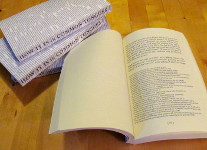How It Is in Common Tongues
Cited from the Commons of digitally inscribed writing by John Cayley & Daniel C. Howe
NLLF [Natural Language Liberation Front] · 296 pages
Some seek diamonds in the rough on the Web; others mine from this lode of language mud and darkness. This profound document was fashioned with snippets of pages, with the search engine, and with the novel first publised as Comment c’est – using all of them quite perversely. Samuel Beckett’s 1964 How It Is describes a person moving and not moving through the mud, alone, not alone, and then once more alone. Cayley and Howe, bending the service known as Google to their literary purposes, have located every phrase of the novel on Web pages where no reference to Beckett is made. For instance, the first words, “how it was I quote,” are found in a New York Times excerpt from Elie Wiesel’s And The Sea is Never Full. The phrase is provided, the URL is given in a footnote … and the same is done for every other phrase in How It Is. The result is an edition of Beckett’s book made of text that was literally found on the Web. The only thing funnier will be the Beckett Estate’s response.


